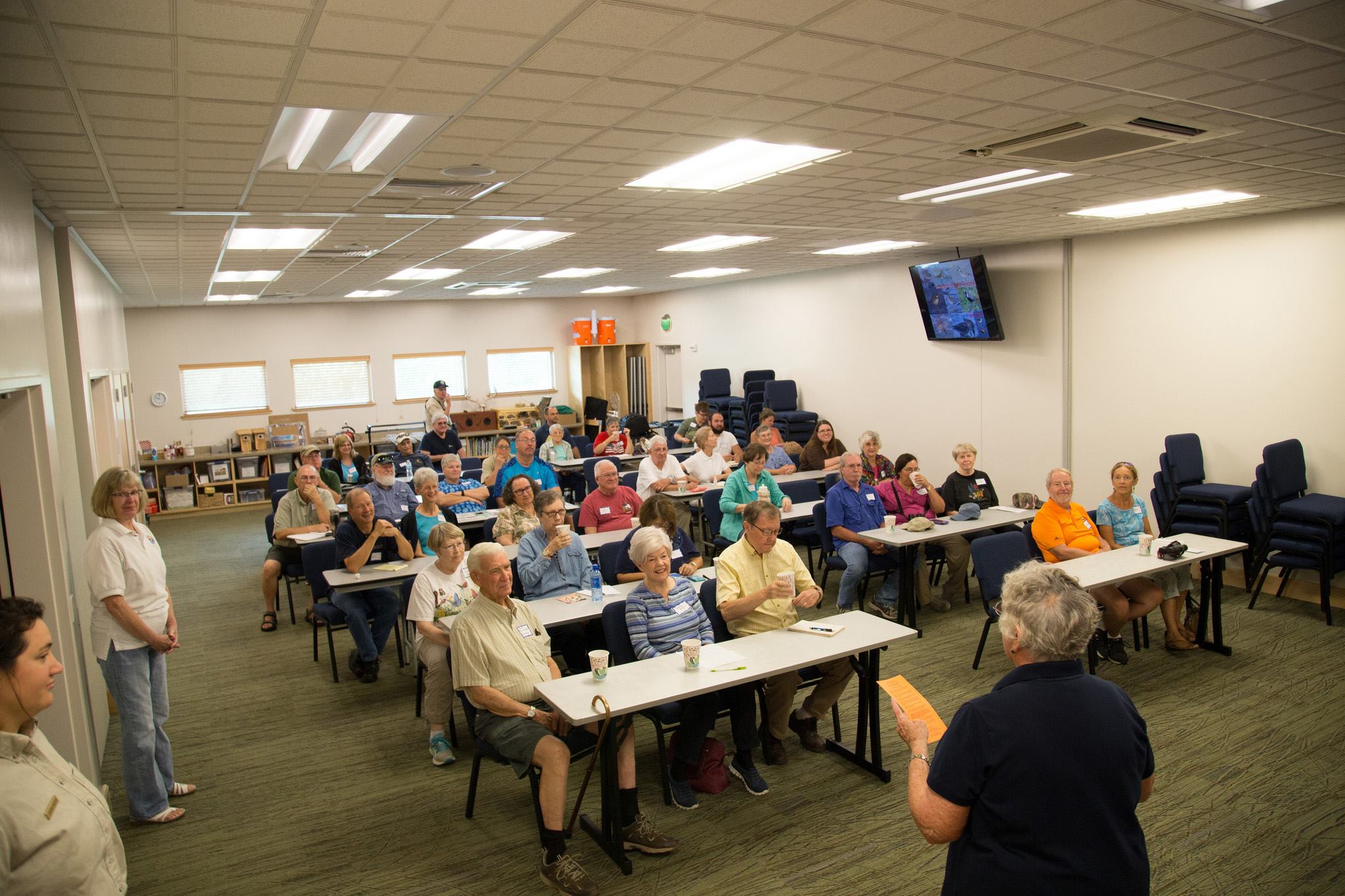|
It is with a heavy heart that we announce the cancellation of our annual spring festival on May 10th due to flooding. Though the major roads are closed, including Wildlife Drive, and tram tours are cancelled, our Bird Walks, Second Saturday, Mother's Day Butterfly Garden Walk, School Field Trips, Fishing Day and Nature'Ology will proceed! See the schedule The theme of our cancelled festival was Nature. In its place we hope you enjoy: An Assortment of Nature Found in Texoma By Spencer Beard and Robert Garza
A World of Pollinators When you think of pollinators what do you think of? There are a lot more pollinators than you may think. Ants, bats, bees, beetles, birds, wasps, and even flies can be pollinators. Some local pollinators you may have seen are the Ruby- throated Hummingbird, the less common Black-chinned Hummingbird, the Texas Flower Scarab, and Paper Wasps. Ruby-throated and Black-chinned Hummingbirds have a specialized beak that enables them to lap up nectar from tubular flowers - only select animals have this ability. While enjoying a sweet beverage the hummingbird may collect pollen on its beak as it moves from one flower to another. |

Black-chinned Hummingbird by James K Waghorne Wasps are interesting pollinators due to the fact they hunt live food such as caterpillars, beetles, and flies. As they move from plant to plant, they may accidentally transfer pollen during a hunt. Their role as a pollinator is minor but should be noted. In addition to incidental pollination, wasps have an active role in ensuring insect populations are in check. Paper wasps are also known to actively consume nectar and other sugar-based substances in addition to hunting. But, all wasps are not pollinators! The beautiful Cuckoo wasp (family Chrysididae), below, is not considered significant pollinator.
Cuckoo wasp by Randall Patterson | Sponsor the Friends With Membership The Little Sit Cancelled Until Further Notice Gardening, Mowing and Work Crew Visitor Center Volunteers Needed! Subscribe to Our Monthly Featherless Flyer |
Pollinators are important to an ecosystem because they allow flowering plants to reproduce. With the growth of more plants, there are more food sources and shelter to support more life which, in turn, promotes diversity. Diversity is important because it allows more pathways for energy and nutrients to be cycled through the ecosystem. In addition to promoting a healthy ecosystem, pollinators also provide a service to our agricultural processes and allow our plants to bear fruit. During spring and fall, many monarch butterflies travel through our area where they forage on blooming wildflowers during migration. If you would like to support pollinators, plant native milkweed and other native wildflowers in your yard! Hey it's a hummingbird! Or.... is it? Hummingbird Moth by James K Waghorne Here we have the Hummingbird Moth. By a strange turn of evolutionary events this moth has taken not only the form and color but body function, feeding habits, and behaviors of the hummingbird. The phenomena are known as convergent evolution. The term refers to the independent evolution of similar features in species of different periods in time. Unlike many insects, this moth is a daytime creature and by disguising itself as a hummingbird the sly moth avoids most predators while feeding in plain sight. Additionally, the Hummingbird Moth can hover just like a true hummingbird for prime feeding access. In order to hover, it moves it’s wings in a figure-eight pattern QUICKLY which allows up-lift and down-lift simultaneously. A Boundless Mollusk: Zebra mussels (Dreissena polymorpha)
Zebra mussels are small, averaging about an inch long. Two inches is approximately the maximum size. USGS The zebra mussel is an invasive species in the Americas. It originated from the freshwaters of Eurasia and is commonly found in the drainages of the Black Sea and the Caspian Sea. The first report of the mussel in America was recorded in 1988 at the Great Lakes. They are believed to have been transported from Eurasia through the ballast water of intercontinental ships. They spread downstream through the Mississippi River and entered other isolated freshwater locations by hitching rides on boats and other water recreation vehicles. Zebra mussel larvae are microscopic and can be unknowingly transported from one water body to another on boats and boat trailers. These mollusks can grow up to 25 mm (about 1 inch). They have triangular bodies can be light or darkly colored and usually have a zigzag pattern on their shells (hence creating a zebra pattern). In order to attach to surfaces, zebra mussels use byssal threads which are silky fibers made of proteins that are secreted from the byssus gland. These mussels can anchor themselves to about anything and slowly crawl by expanding and retracting their byssal threads. Zebra mussels pose a great threat to our local species because of their ability to alter habitats through fast reproduction and colonization. When these prolific filter feeders are introduced to a new environment, they compete with native species for the same food source.
Zebra Mussels on Shoreline Rock: An image depicting zebra mussels attached to a rock along the shoreline, highlighting their invasive nature. USGS With less plankton drifting in the water, the water becomes more transparent which allows additional light to reach deeper into the water body. The excess light allows aquatic plants to spread deeper into the bodies of water and change the benthic composition. Some species would be able to adapt to new changes but many more would suffer from competition and an altered habitat. Zebra mussels also affect infrastructure and recreation by encrusting items with colonies including community water intake pipes. Zebra mussels are very difficult to control. Even catfish can spread the larvae through their feeding behavior! The best method to help control the spread of this invasive species is to clean and dry recreational items (boats, kayaks, buckets) after each use and help make the public more aware of the species through education and signage. |
Refuge Update: At this time, Lake Texoma is projected to crest at 630.4 MSL on May 7th which is 8 feet higher than the current level. The forecast level includes only rain that has fallen to date. The red line on the map below shows where the lake will be at 630 MSL. Many Refuge roads will be closed for several weeks to come so please plan accordingly. The Visitor Center will remain open as usual unless the lake level exceeds 634 MSL
|
Photos by Brenda Kay Edwards More Amazing Nature Photos taken at the refuge (Facebook account required.) |
Upcoming Activities:
The Friends of Hagerman is Hosting 9 Family Friendly Events in May! Donate to help fund programs like these! |
|
Second Saturday: Wilding Your World With Karen Glenn, TMN Saturday, May 10 at 10:00 AM in the Visitor Center Photo by Jennifer Vince-Recksiek As more land becomes developed across north Texas, protecting wild spaces, along with native flora and fauna, is an increasingly critical need for our area. Find out how you can help by adding some wild areas on your property to support the ever-growing gaps between fragmented native habitats. No space is too small. We will cover some basic concepts of rewilding, a few important ecological relationships, and alternative management techniques that better support our native plants and animals. Future Second Saturday Programs |
|
Mother's Day Butterfly Garden Walk Sunday, May 11, 2025 at 2:00 to 4:00 PM
Photo of Summer Azure by Laurie Sheppard
Registration is not necessary |
Birding with Jack: The Weekly Bird Census Left to Right: Mike Petrick, Nancy Riggs, Jack Chiles and Terry Goode Each Tuesday a team of experienced birders, including Master Naturalist Jack Chiles, traverse 35 miles of refuge roads and hiking trails, documenting every bird they encounter. This Bird Census is reported to The Cornell Lab of Ornithology for use in research, and each week we will bring you a link to their actual bird count, and a summary of their adventures.
Bobolinks and a Western Cattle Egret in breeding plumage It was a beautiful day for the census. Lake waters continue to rise and you can no longer access the west side of the refuge via Bennett Lane so we had to go around via Hwy 82 to do the census there. The pads are becoming inundated and Wildlife Drive, the main road thru the refuge will probably be closed Wednesday morning. The Bobolinks are arriving in good numbers and we counted 30 today. Some of them let us get very closeup views. They were singing continuously. There are no mudflats and the only shorebirds that can be seen are in high vegetation. If you want to see the Bobolinks tomorrow will probably be the last good chance for a while. Silliman road is probably the best place to look for them. There are still a few mature Yellow-headed Blackbirds in the same area. We saw a lone Clay-colored Sparrow on Plover Pad by the pumpjacks. We also saw a lone Black Tern way out off the end of Plover sitting on a snag. We saw and heard Bell's Vireos on Enterprise Rd. Painted Buntings are present in good numbers as well as Indigo Buntings. Mississippi Kites have arrived and we counted 4. There were 17 White-faced Ibis in the small marsh on the left going down Wildlife Drive before arriving at the entrance to Plover Pad. We finished the day with 96 species, very good, considering there were few shorebirds. Today's photos, Bobolinks and a Western Cattle Egret in breeding plumage. Watch for the census results every Tuesday evening: Bird Census Results |
The Friends of Hagerman NWR Photo Club Meeting: Wildflowers and Dragonflies Saturday, May 17, 2025 in the Visitor Center |
Nature'Ology: A Fun Day of Learning About Nature! A free single day camp for children 11 or 12 years old Saturday, June 7th, 2025 A full day of learning all about nature: fossils, prairies, spiders, birds, snakes and water cycles! Make a terrarium, enjoy a nature craft and meet other young nature enthusiasts! This program has become so popular, that it fills up very quickly. As a pre-registrant, you will be emailed a link to apply for a confirmed reservation on Wednesday, May 7th at 10:00 AM, one day before reservations become available to the general public. The first 30 students to complete registration on or after May 7th will be granted a confirmed reservation. |
Join Cindy Steele for: The 2025 Free Fishing Event For Children 16 and Under Saturday, May 17, 2025, 9:00 - 11:00 AM NOTE: This event will be held at the ponds along Refuge Road, East of the Visitor Center, which are unilkely to flood. Calling all kids! Let’s Go Fishin’ on Saturday, May 17th at the with Hagerman NWR staff and volunteers. This special Refuge Rocks event is for youth ages 16 and under. We will be fishing from 9:00 a.m. to 11:00 a.m. and is open to children ages 16 and under. With the help of volunteers, kids will be able to demonstrate their fishin’ skills! Gear will be available for kids to check out and bait will be provided. No registration is required for this event, and you can come and go as you please. We’ll also be providing a fishing-themed craft table. Registration is not necessary for this very special event. |
| Puddles' Craft Corner By Cindy Steele, Master Naturalist Learn about nature while making a nature craft with Puddles! Much more than detailed craft instructions, these activities include information about the creature being made, supply lists and pictures of every step! |
It's Bluebonnet Time!

When the Texas wildflowers blanket the fields across the state, Texans have never been able to stay indoors. We’re always thinking of ways to get outside. This is especially true when our beloved bluebonnets begin to paint our fields and roadways this beautiful shade of blue. Texans have a deep love for bluebonnets, and this is seen every year when families load up in the car and head on road trips across the state to take family photos in fields of bluebonnets. We are so proud of our bluebonnets here in the Lone Star State we officially made the sandy land bluebonnet, Lupinus subcarnosus, our official state flower in 1901 after beating out the cotton boll and cactus in a heated debate in the Texas Legislature. However, the sandy land bluebonnet is not the species of bluebonnet that Texans have a deep love with. That honor goes to the Texas bluebonnet, lupinus texensis, which is showier than the sandy land bluebonnet. For this reason, in 1971 the Texas Legislature amended the law by adding both species as the official state flower and any other bluebonnets yet to be discovered growing in Texas. Would you like to take a guess of how many species of bluebonnets can be found in Texas? There are six different species of bluebonnets found in Texas, and they are all considered the official state flower of Texas.
Our beloved bluebonnet is just one of the many beautiful wildflowers that grace our landscapes each spring and summer. Many of us have spent most of our lives in and around the rural areas of north-central Texas and south Oklahoma, surrounded by a varied and colorful display of wildflowers from early March through the end ofJune. Growing up, I had my favorites – the Evening Primrose and our beloved Texas Bluebonnet. Though each spring greeted us with more than just these bright beauties, I only had eyes for my two favorites. As a child, I didn’t even realize that there was a cycle and order to the wildflower season. The Indian Paintbrushes come and go, and then before the Bluebonnets are gone, the delicate-pink...
Continue the Lesson With Full Instructions and other Nature Crafts with Puddles
Junior Ranger Program
|
| The Junior Ranger Pledge As a Junior Ranger at Hagerman National Wildlife Refuge, I pledge to protect outdoor creatures small, big and huge. To keep the water, air and land clean. To make enjoying nature a routine. I will share my new skills with family and friends. When people and nature work together, everybody wins! |
|
Sponsors Enable the Friends to…
Join Today! Memberships available for $10 |
Tram Tours are cancelled until further notice due to flooding. Click here to be notified when tram tour reservations resume. Come join us for a ride on the Wildlife Explorer! Our beautiful tram is available for ninety-minute tours of Hagerman every Saturday and Sunday, weather permitting. Our tours are as varied as our drivers. Each tram driver has her/his approach to the tour: you may learn about wildlife, birds, habitat, refuge history, photography, you name it! To paraphrase, “a Wildlife Explorer tour at Hagerman is like a box of chocolates, you never know what you’re going to get.” But you know it’s going to be good! Come see us! Lots of stops for bird-watching and photography. |
Pipevine Swallowtail (right) by Laurie Sheppard |
Early Bird Walk with Jack Chiles Master Naturalist Jack Chiles will lead our Early Birding event, weather permitting. Bring binoculars or borrow ours. Meet at the Visitor Center and return in time for the Second Saturday program. Please Register (Optional) so we may inform you via email of unforseen changes/cancellations. |
Do You Like to Work Outside? The Refuge Needs You! |
It takes a lot of people to have a beautiful garden! The Wednesday Garden Team Love to work with native plants and meet other gardeners? Come and help us add plants, weed and mulch our beautiful butterfly garden. Garden Team volunteers get first dibs on thinned native plants as well as access to seeds and cuttings for propagation. Gardeners meet on most Wednesdays, but times vary. Contact Us to subscribe to the volunteer garden team weekly email. Provide own tools and gloves. Minimum age 18, or 16 if accompanied by parent/volunteer. |
Mowing and Refuge Beautification: The Work Crew Do you enjoy working outside, mowing, sprucing up hiking trails, trimming and removing brush and general cleanup? Show your love for nature by joining the Outdoor Crew at Hagerman National Wildlife Refuge. Outdoor Crew volunteers meet on the First Tuesday and Fourth Saturday of every month. Contact Us for exact times, dates and other details about joining the volunteer Work Crew. Scouts welcome! |
Visitor Center Volunteers Needed! |
Do you enjoy meeting all kinds of people from all over the world, and like-minded people in our area? If yes, consider joining our team of Visitor Center Volunteers. You will greet refuge guests, distribute maps and other refuge information, and make sales in the gift shop. Shifts available every day of the week: Monday through Saturday 9 AM to 12:30 PM and 12:30 to 4:00 PM, Sunday 1:00 to 5:00 PM. Training is provided. Contact Us if interested. |
| Thank You To Our Contributors: Jack Chiles, Cindy Steele, Brenda K Edwards, Nancy Miles Miller, Randall Patterson, Jennifer Vince-Recksiek, James Waghorne Refuge Manager: Kathy Whaley Visitor Services Manager: Spencer Beard Friends of Hagerman NWR Foundation 6465 Refuge Road, Sherman, TX 75092 Phone: 903-786-2826 Join us on Facebook: |
Search for any word--do not use quotes for phrases |
Kroger: Stop by the customer service desk at Kroger and link your Kroger Card to the Friends of Hagerman: the Friends will get rewards for every dollar you spend, at no cost to you.
Please add info@friendsofhagerman.org to your contacts to ensure delivery of registration confirmations, account information and the Featherless Flyer
See you at the refuge!


 Photo by James K Waghorne
Photo by James K Waghorne




















